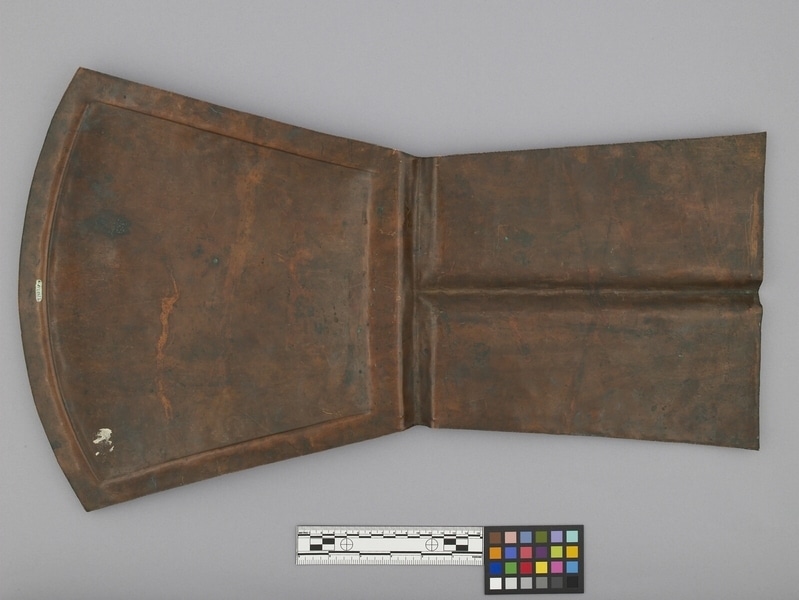Copper Item Number: Nb3.1309 from the MOA: University of British Columbia


Description
Traditional shield-shaped whole copper with a T-shaped raised design element that divides the bottom section in half and separates the top section from the bottom. The top portion has sides that flare outwards and a curved top edge. The top portion has a flat border surrounding a convex area decorated with a face. The drawing of the face and a series of parallel lines on the lower portion of the copper have been engraved through a blackened (lead) surface to reveal the copper underneath.
History Of Use
Coppers can be named, displayed, and transferred in accordance with ceremonial privilege and protocol. Historically, within potlatch economies, coppers would rise in value each time they were purchased, ceremonially presented, and strategically re-sold or given away. Among the Kwakwaka’wakw, coppers were sometimes cut or broken during rivalries. Some of these were riveted together and used again, their value then having to be re-established.
Narrative
Margaret Frank's grandson (by her daughter Mary), Andy Everson, thinks this copper was used for a grease potlatch.
Iconographic Meaning
The crest of the original owner is usually portrayed on the copper.
Cultural Context
status; wealth; ceremonial; potlatch
Item History
- Made in British Columbia, Canada
- Collected in Fort Rupert, British Columbia, Canada and Tsaxis, British Columbia, Canada during 1966
- Owned by Margaret Frank and Mrs. Stanley T. Arkley
- Owned by Stanley T. Arkley before May 16, 1976
- Received from Stanley T. Arkley (Donor) on May 16, 1976
What
- Name
- Copper
- Identification Number
- Nb3.1309
- Type of Item
- copper
- Material
- copper metal and lead metal
- Manufacturing Technique
- cut, hammered, painted and engraved
- Overall
- height 60.1 cm, width 35.6 cm, depth 2.3 cm
Who
- Culture
- Kwakwaka'wakw
- Previous Owner
- Margaret Frank, Mrs. Stanley T. Arkley and Stanley T. Arkley
- Received from
- Stanley T. Arkley (Donor)
Where
- Holding Institution
- MOA: University of British Columbia
- Made in
- British Columbia, Canada
- Collected in
- Fort Rupert, British Columbia, Canada and Tsaxis, British Columbia, Canada
When
- Collection Date
- during 1966
- Ownership Date
- before May 16, 1976
- Acquisition Date
- on May 16, 1976
Other
- Item Classes
- metalwork
- Condition
- good
- Current Location
- Case 27
- Accession Number
- 0306/0001